Opalite is a kind of synthetic glass that is replacing real gemstones. Other names for it include moonstone, sea opal, and opalized glass. Because of its milky, opalescent look that mimics the range of colors found in actual opals, the stone is highly valuable.
It is not a real mineral or gemstone, despite what its name and look may suggest. Usually, opalescent glass is used instead of another kind of glass. To achieve the unique iridescent quality, different minerals, metals, and other components are combined during the manufacturing process. The stone is a common material for beads, pendants, and other ornamental applications in jewelry-making.
It’s crucial to understand that Dendritic Opal is not the same as natural opal, which is an actual natural gemstone. Opalescence, or the dance of hues produced by light diffracting through silica spheres, is the characteristic of natural opal. The geological and mineralogical characteristics of real opal are absent from artificial opal.
Table of Contents
Opalite Properties
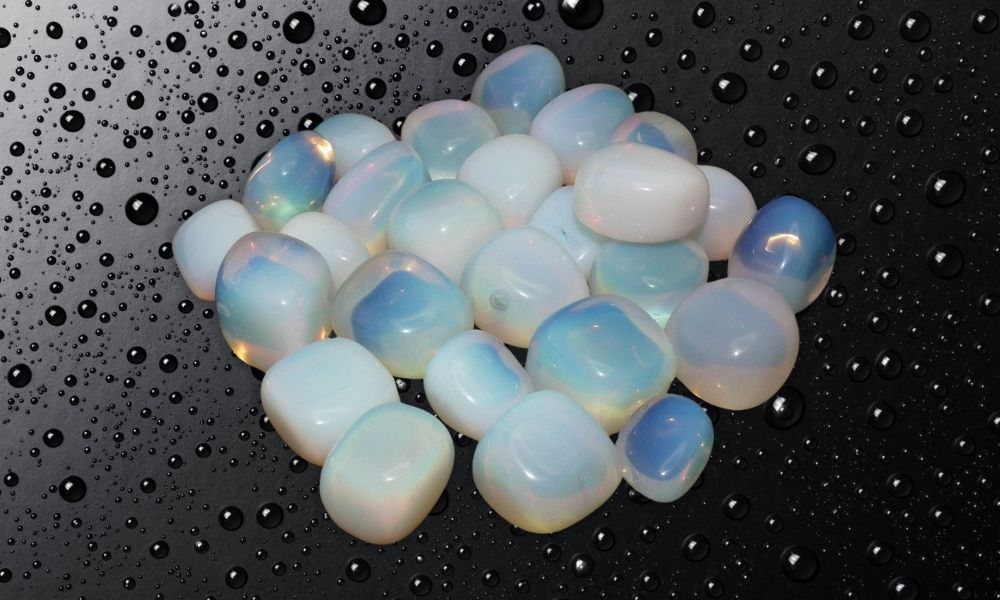
Since it is a synthetic material, it lacks the therapeutic and mystical qualities associated with real gemstones. On the other hand, some individuals think that it has the following metaphysical qualities:
Calming and Soothing
The stone is frequently connected to a relaxing and comforting aura. It aids in calming emotional upheaval and promoting serenity and quiet. It aids in emotional equilibrium and reduces depressive, anxious, and stressed moods. This stone opens your heart to receive good vibrations. Wear it as a pendant or carry a piece in your pocket to absorb its relaxing energy throughout the day.
Enhancing Communication
Some people think that the stone can improve spiritual communication as well as all other forms of communication. It encourages improved verbal communication and transparency.
Balancing Energy
It provides an energy-balancing function that helps to balance the body’s yin and yang forces. Its equilibrium promotes general well-being.
Aiding in Transition
The stone is occasionally connected to changes and transitions. It assists people in adjusting to life transitions by offering encouragement and support.
Enhancing Psychic Abilities
It improves psychic and intuitive talents in esoteric circles. People apply it to spiritual activities like meditation to help establish a link with higher planes. The stone encourages self-discovery by connecting to your higher self and disclosing buried truths. It enables you to make connections with your desires and design a life that fulfills your requirements. Place the stone on your forehead or crown of your head and meditate, letting its energy lead you to a better comprehension of who you are.
Growth
It encourages self-improvement and helps break old patterns, both of which contribute to personal progress. This stone promotes mental, emotional, and spiritual development. When you meditate with this stone on your Crown Chakra or Third Eye, picture your objectives and the actions required to reach them.
Creativity
Working with this stone encourages original thought and the free exchange of ideas. It is the perfect stone for authors and artists because of its shimmering colors, which encourage creative expression. Place the stone in your workspace to enhance creativity whether you are working on creative tasks or coming up with fresh ideas.
It is vital to remember that there is no scientific data to back these ideas, rather these are metaphysical and spiritual viewpoints. Different people can experience different qualities with this stone. It’s important to approach the use of crystals and gemstones for metaphysical purposes with an open mind and personal knowledge of their symbolic or energy value if you’re interested in doing so.
Physical Characteristics of Opalite Crystal
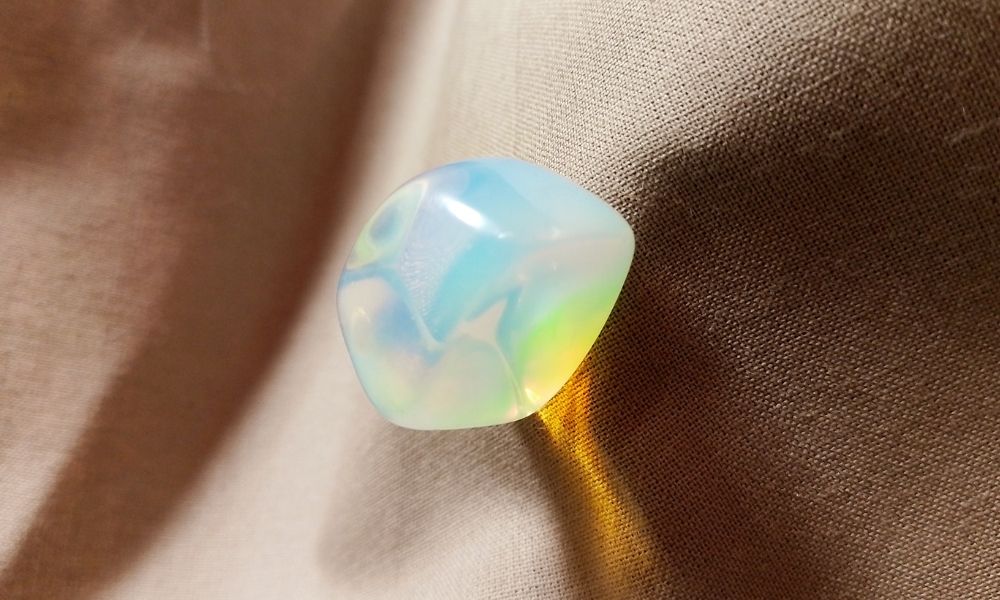
Although some manufacturers may utilize other materials (such as plastic resin), it mostly comprises synthetic glass and metal. Despite originally referring to a specific type of opal gemstone, people often linked the term “opalite” to synthetic opal since the 1980s.
People also refer to it as purple opal, ice cream stone, Tiffany stone, common opal, and opalized fluorite. People distinguish it from genuine opal by subjecting it to UV light. It is not natural opal; rather, it is opalite if it glows green when exposed to UV radiation.
Opalite gemstones can be translucent or opaque, but they are usually iridescent and have milky white to blue undertones. But not all gemstones are the same shade of white-blue;, when exposed to light, opalite’s color play produces a wide range of hues within the stone.
They are frequently much more vivid than natural opals due to their manufacturing process. The process known as “play-of-color” is what causes opals to change hue. The gem reflects a rainbow’s worth of hues as light enters and bounces off the molecules inside.
How to Use Opalite?

It is perfect to utilize when things are changing or chaotic. You can wear it as jewelry, simply have it nearby, especially in the space (the workplace, bedroom, etc.) where you feel the most need for it, or even include it into your meditation routine.
Cleansing Opalite
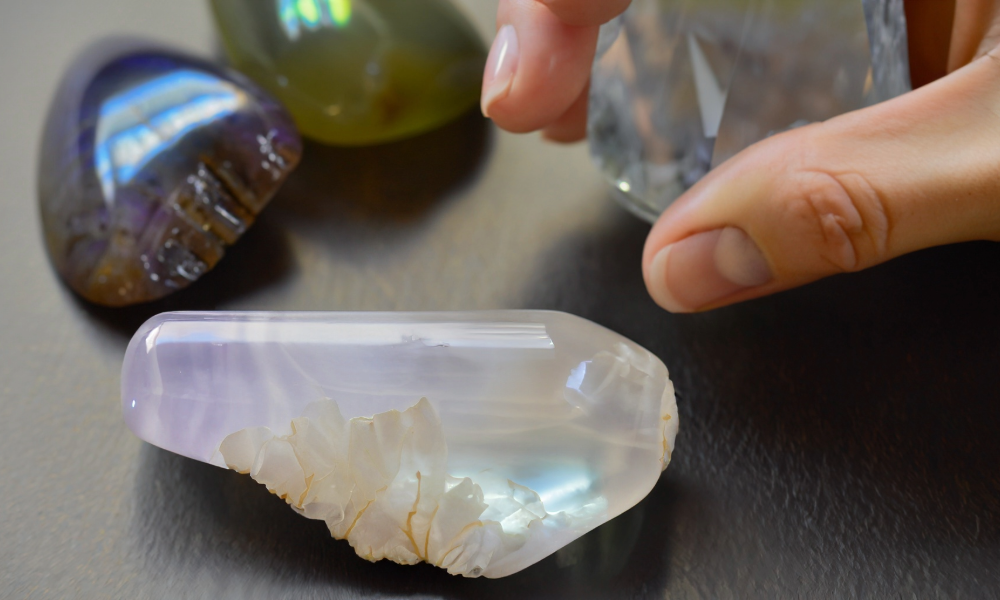
Spiritually cleanse the crystal, just like other healing stones. You should do it when you first get it, after extended periods of non-use, and occasionally throughout normal use. Cleanse it either by smudging it or by overnight leaving it in a specific amethyst or quartz container.
For cleaning, geodes, druses, beds, and clusters are suitable containers. Both quartz and amethyst can absorb and counteract any bad energy inside the stone. Smudging, on the other hand, is holding the stone in the incense or smudging smoke while it burns.
Opalite beads
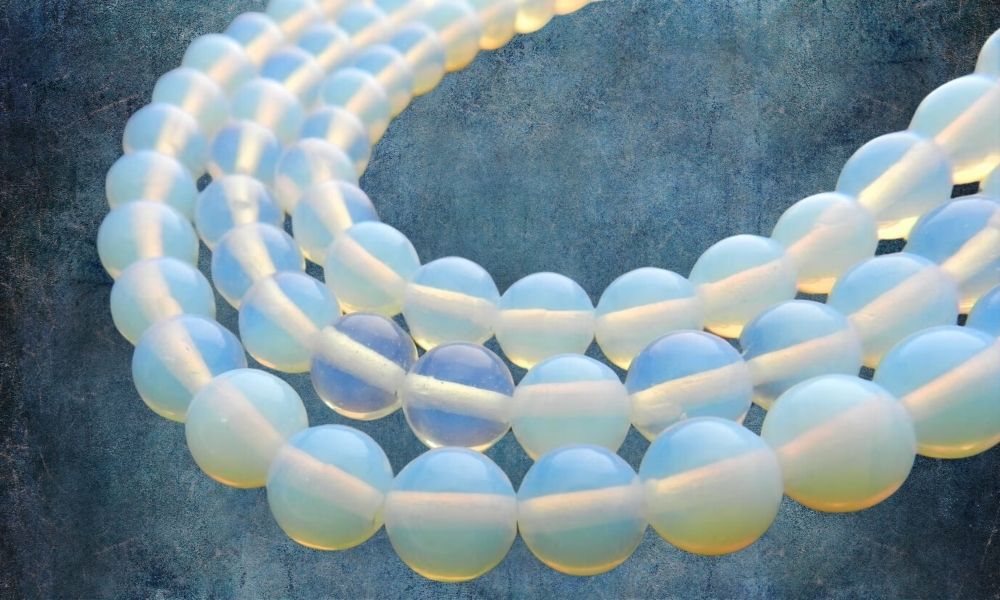
Opalite is a man-made glass that has an iridescent or opalescent look. It’s beads are small, ornamental beads created from this glass. These beads are frequently utilized in jewelry-making, enabling artisans to produce creations that resemble real opals. Here are some essential details regarding these beads:
- Opalite is a kind of synthetic glass used to make beads. This glass has a milky or translucent base with a chromatic play of colors to mimic the appearance of natural opals.
- Its beads frequently feature iridescent flashes of color and a milky, whitish appearance. They are available in shades of pink, violet, green, and blue to create a lovely and ethereal impression.
- Its beads are available in a variety of forms and sizes, such as chips, ovals, rounds, and more. The beads can have distinct textures and visual effects depending on whether they are faceted or smooth.
- These beads are well-liked options for making bracelets, earrings, necklaces, and other jewelry. They are a favorite among craftsmen due to their appealing appearance and affordability.
Opalite Dice

It is a man-made glass that has an iridescent or opalescent look. Opalite dice are made of this glass. Tabletop gamers, particularly those who appreciate role-playing games such as Dungeons & Dragons (D&D), are fond of these dice. These dice are highly valuable due to their ethereal and captivating appearance.
These dice are frequently used in tabletop games and come in a variety of sizes and forms. Although the typical 6-sided die (d6) is the most popular design, there are other shapes of dice as well, including 10-sided dies (d10), 20-sided dies (d20), and more.
The dice are available in different packages for tabletop games. There are usually a d20, d12, d10, d8, d6, and d4 in a set. For percentage rolls, certain sets additionally come with extra d10s. Tabletop gaming aficionados frequently collect these dice because of their distinctive and eye-catching appearance. Some people choose these dice because they are visually appealing and make a statement at the game table.
Moonstone vs. Opalite
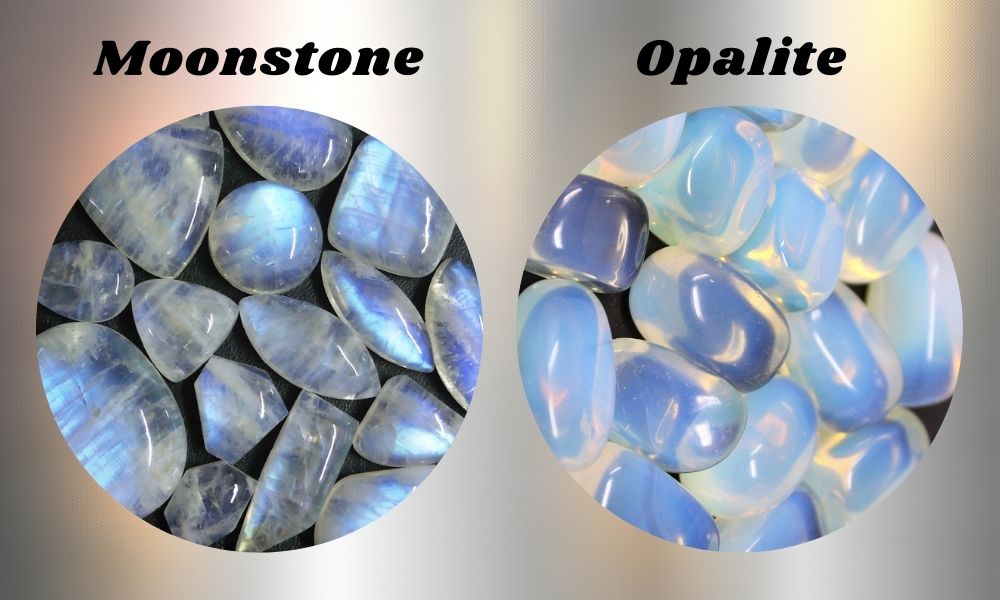
As opposed to opalite Moonstone is a natural gemstone. Below we discuss what it looks like and its significance.
Moonstone is a stunning and ethereal gemstone that has an unusual adularescence, or shimmering or floating light look. The dispersion of light as it strikes small layers of various feldspar minerals within the stone is what produces this look. The most prevalent colors of moonstone include white, gray, peach, and blue. One of the greatest stones for teenagers is the moonstone since it facilitates emotional equilibrium and emotional connection.
It makes you more sensuous and fertile and helps you connect with your inner goddess. Its name comes from a sheen, or optical effect, produced by light diffraction inside a microstructure made up of typical Feldspar and Albite exsolution layers.
Clear to silvery-white are the most common colors; some even have stunning blue or rainbow-like sheens. Adularescence is the term for the stunning light patterns that Moonstone frequently exhibits when it turns. Ancient cultures used moonstones in their jewelry. The Romans loved it and thought it came from the Moon’s frozen rays. It shares the June birthstone designation with Alexandrite and Pearl.
In honor of the moon landings, moonstone is the official state jewel of Florida. The shuttle launched from Florida’s Kennedy Space Center. But Florida isn’t a natural habitat for moonstones.
Comparing Moonstone and Opalite: Similarities
While moonstone and opalite have different histories and characteristics, there are notable similarities between their metaphysical advantages. Let’s examine five commonalities between these stones.
- They have similar appearances. Moonstone and Opalite offer different luminosity and color-shifting effects. Each features delicate colors that shift under different lighting.
- These stones are associated with the Moon and radiate feminine energy, which gives you access to their comforting and calming properties.
- Moonstone and opalite affect the Third Eye Chakras and the crown, which gives inner serenity, spiritual awareness, and intuition.
- Both gemstones have potent healing qualities that impact the emotional body. These benefits include lowering stress levels, promoting calm and tranquility, and assisting in the balancing of emotions.
Comparing Moonstone and Opalite: Differences
The key differences between these two stones are:
- Deep within the Earth, moonstone is an organic crystal that has formed over millions of years. Opalite is a synthetic crystal that is artificially created by humans in a laboratory.
- On the Mohs hardness scale, moonstone ranges from 6 to 6.5, while opal often receives a 6, though the manufacturing process can affect this number.
- It is a recent invention and a very new addition to the crystal universe. However, moonstone was in use by ancient civilizations for thousands of years.
- While it connects to the numerology number 9, which connects with the conclusion of a cycle and the beginning of a new phase, Moonstone connects with the number 4, which represents stability and pragmatism.
- It is much cheaper than a moonstone gemstone.
(FAQs) about Opalite
Q1. What is Opalite good for?
Opalite is supposed to help combat fatigue and stabilize mood fluctuations. It supports you in overcoming your worries and embracing change. As a merchant stone, it aids in the manifestation and accumulation of financial gain. It is a cornerstone of business and promotes achievement in all undertakings.
Q2. Is Opalite real or fake?
How do you define an opalite? These stones are artificial, in contrast to entirely natural ones. Although they resemble opals, they are made up of resin, plastic, and glass. Since they are not natural, people call them “fakes” or synthetic stones as a result.
Q3. Does Opalite glow in the dark?
Opalite glows a bright pink or blue when positioned against a black background.
Q4. Can Opalite be natural?
Opalite is a term that describes both artificial and natural opal. The natural one is a densely included, naturally occurring green or purple opal that frequently exhibits chatoyancy or the “cat’s eye effect.” It is not artificial.
Q5. Is Opalite a glass or stone?
Synthetic opalescent glass and several opal and opalite imitators come under the trade name moonstone.” This glass product has the names argon, sea opal, opal moonstone, and other comparable terms.
Q6. Is Opalite for good luck?
Opalite draws wealth and prosperity as well as supports professional and economic success. Meditation using the stone can aid in mental clarity and spiritual development.
Stay Tuned to Gems Tycoon for all gems-related articles.









